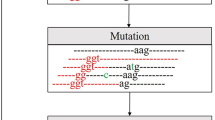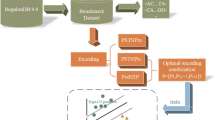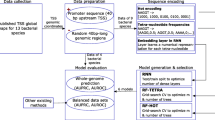Abstract
The identification of functional motifs in a DNA sequence is fundamentally a statistical pattern recognition problem. This paper introduces a new algorithm for the recognition of functional transcription start sites (TSSs) in human genome sequences, in which a RBF neural network is adopted, and an improved heuristic method for a 5-tuple feature viable construction, is proposed and implemented in two RBFPromoter and ImpRBFPromoter packages developed in Visual C++ 6.0. The algorithm is evaluated on several different test sequence sets. Compared with several other promoter recognition programs, this algorithm is proved to be more flexible, with stronger learning ability and higher accuracy.
Similar content being viewed by others
References
Roderic Guigo. Computational gene identification: an open problem. Computers Chem, vol. 21, no. 4, pp. 215–222, 1997.
James W. Fickett. The gene identification problem: an overview for developers. Computers Chem, vol. 20, no. 1, pp. 103–118, 1996.
Anders Gorm Pedersen, Pierre Baldi, Y. Chauvin. The biology of eukaryotic promoter prediction — a review. Computers & Chemistry, vol. 23, no. 6, pp. 191–207, 1999.
Uwe Ohler, Heinrich Niemann. Identification and analysis of eukaryotic promoters: recent computational approaches. Trends in Genetics, vol. 17, no. 2, pp. 56–60, 2001.
James W. Fickett, Artemis G. Hatzigeorgiou. Eukaryotic Promoter Recognition. Genome Research, vol. 7, no. 9, pp. 861–878, 1997.
Tao Jiang, Ying Xu, Michael Q. Zhang. Current Topics in Computational Molecular Biology. Tsinghua University press, Beijing, pp. 101–255, 2002.
G. B. Hutchinson. The prediction of vertebrate promoter regions using differential hexamer frequency analysis. Bioinformatics, vol. 12, no, 5, pp. 391–398, 1996.
Michael Q. Zhang. Identification of Human Gene Core Promoters in Silico, Genome Research, vol. 8, pp. 319–326, 1997.
Zhaoqi Bian. Pattern recognition, Tsinghua University Press, second edit, Beijing, pp. 250–270, 2000.
Author information
Authors and Affiliations
Corresponding author
Additional information
This work was supported by the National Natural Science Foundation of China (No.60374069)
Zhi-Hong Peng received her Ph.D degree in Central South University. She is currently a professor at Beijing institute of technology. Her research interests include bioinformatics, intelligent control and intelligent systems.
Jie Chen is a Full Professor and Head of Department in the Department of automatic control. He received his PhD degree at Beijing institute of technology. His research interests include bioinformatics, intelligent control and intelligent systems.
Li-Jun Cao received her master degree in Beijing institute of technology. Her research interest is bioinformatics.
Ting-Ting Gao received her Bachelor degree in China Agricultural University. She is currently a master candidate at Beijing institute of technology. Her research interest is bioinformatics.
Rights and permissions
About this article
Cite this article
Peng, ZH., Chen, J., Cao, LJ. et al. Identification of TSS in the human genome based on a RBF neural network. Int J Automat Comput 3, 35–40 (2006). https://doi.org/10.1007/s11633-006-0035-7
Received:
Revised:
Issue Date:
DOI: https://doi.org/10.1007/s11633-006-0035-7




